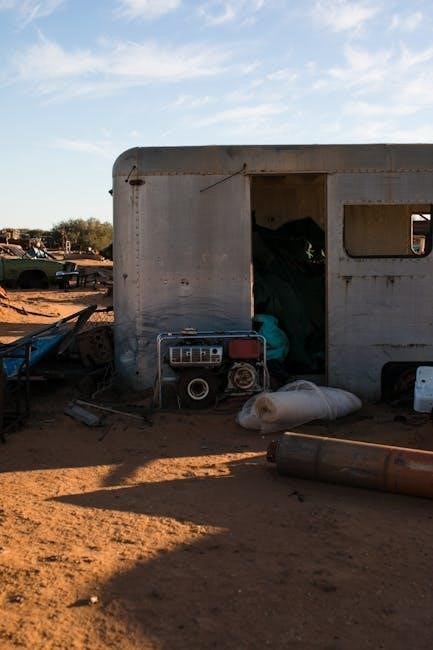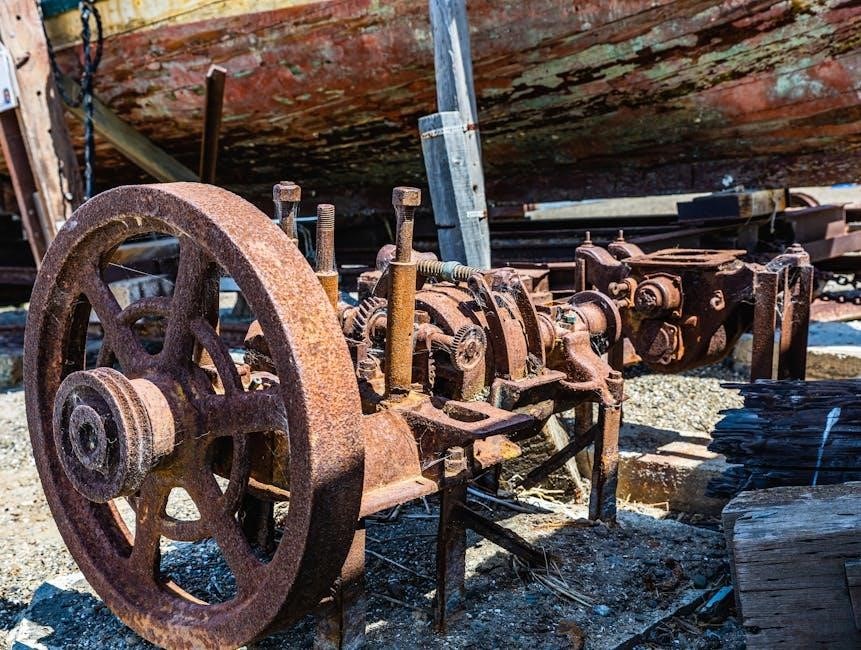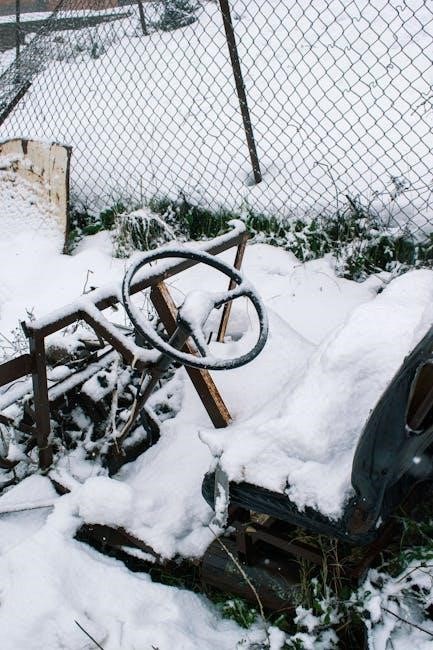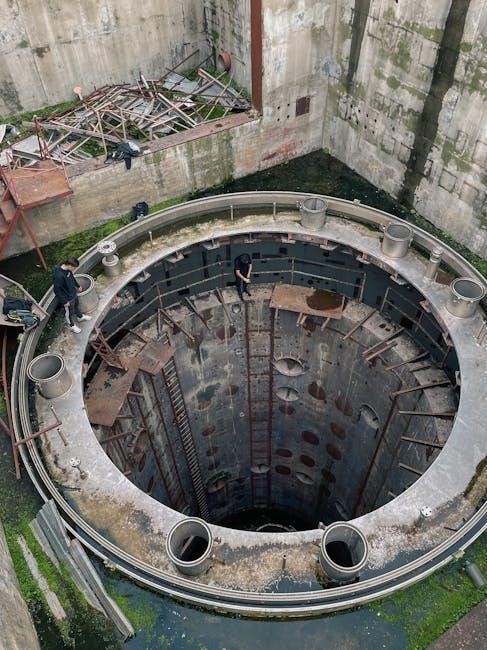scrap metal identification guide pdf
Scrap metal identification is essential for maximizing value and ensuring responsible recycling. This guide provides a comprehensive overview of techniques, from magnet tests to spark examinations, helping enthusiasts and professionals accurately identify metals like copper, aluminum, and steel, while adhering to industry standards and environmental regulations.
Why Scrap Metal Identification Matters
Accurate scrap metal identification is crucial for maximizing profits, ensuring environmental compliance, and maintaining industry standards. Properly identifying metals like copper, aluminum, and steel allows for correct pricing, efficient recycling, and adherence to legal requirements. Misidentification can lead to financial losses, environmental hazards, and regulatory penalties. Understanding the value and properties of metals ensures responsible recycling practices, supports sustainable resource management, and promotes a circular economy. It also helps businesses and individuals avoid illegal activities and contribute to a greener future.
Overview of Common Scrap Metals
Common scrap metals include ferrous metals like iron and steel, known for their magnetic properties, and non-ferrous metals such as copper, aluminum, and brass, prized for their durability and conductivity. Copper is recognizable by its reddish hue and is often found in wiring, while aluminum is lightweight and corrosion-resistant. Brass, an alloy of copper and zinc, is commonly used in fixtures and hardware. Accurate identification of these metals is key to determining their value and ensuring proper recycling practices, making them essential components in the scrap metal industry.

Understanding Metal Types
Understanding metal types is crucial for effective scrap metal identification. Ferrous metals, like iron and steel, contain iron and are magnetic. Non-ferrous metals, such as copper, aluminum, and brass, lack iron and are non-magnetic, offering unique properties for various applications.
Ferrous Metals: Iron and Steel
Ferrous metals, primarily iron and steel, are widely recognized for their magnetic properties and high strength. Iron, often alloyed with carbon to create steel, is a cornerstone in construction and manufacturing. Steel, known for its durability and versatility, is commonly found in scrap from appliances, vehicles, and structural materials. Identifying ferrous metals is straightforward due to their magnetic nature, making them a key focus in scrap metal recycling. Accurate identification ensures proper sorting, recycling, and maximization of their market value, contributing significantly to the scrap metal industry’s sustainability and profitability.
Non-Ferrous Metals: Copper, Aluminum, and Brass
Non-ferrous metals, such as copper, aluminum, and brass, are highly valued for their non-magnetic properties and excellent conductivity. Copper, recognizable by its reddish hue, is commonly found in wiring and electronics. Aluminum, lightweight and corrosion-resistant, is often sourced from cans and machinery. Brass, an alloy of copper and zinc, is durable and used in fixtures and hardware. These metals command higher prices due to their versatility and demand, making accurate identification crucial for maximizing returns in scrap metal recycling and resale markets.

Testing Techniques for Scrap Metal
Identify metals using magnets, spark tests, and visual inspections. These methods help determine metal types, ensuring accurate identification and valuation for efficient recycling and resale processes.
Using a Magnet to Identify Ferrous Metals
A magnet is a simple yet effective tool for identifying ferrous metals, which contain iron. Ferrous metals, like steel and iron, are magnetic, while non-ferrous metals, such as copper and aluminum, are not. To test, hold a magnet near the metal; if it attracts strongly, it’s ferrous. This method is quick and practical for sorting scrap metals. Non-ferrous metals may exhibit weak attraction due to impurities but will not stick firmly. This basic test is a crucial first step in identifying and categorizing scrap metal efficiently.
The Spark Test: Identifying Metals by Spark Patterns
The spark test identifies metals by observing the spark patterns produced when a metal is scraped against a grinding wheel. Ferrous metals, like steel and iron, create bright, white sparks with a sparkling tail, while stainless steel sparks less intensely with an orange tint. Non-ferrous metals, such as aluminum, produce fewer sparks, and copper typically does not spark at all. This method helps differentiate between metal types based on their composition and alloy properties, providing a reliable tool for accurate identification in scrap metal recycling.
Visual Inspection: Color and Physical Properties
Visual inspection is a crucial step in identifying scrap metals. Metals exhibit distinct colors: copper is reddish, aluminum is silvery, and brass has a yellowish hue. Physical properties like texture, weight, and surface finish also provide clues. For instance, aluminum is lightweight and often has a smooth, dull finish, while steel is heavier with a metallic sheen. This method allows for quick differentiation between ferrous and non-ferrous metals, aiding in efficient sorting and recycling processes. Combining visual cues with other tests enhances accuracy in metal identification and valuation.

Industry Standards and Regulations
Industry standards and regulations ensure ethical and safe scrap metal recycling. Compliance with legal requirements and environmental rules is crucial for sustainable practices and proper documentation.
Scrap Metal Dealers Act 2013: Legal Requirements
The Scrap Metal Dealers Act 2013 establishes legal frameworks for scrap metal operations, ensuring transparency and accountability. It requires dealers to maintain accurate records, verify seller identities, and report transactions. Proper documentation is mandatory, and non-compliance can lead to penalties. The Act also mandates environmental compliance, emphasizing responsible recycling practices. Adhering to these regulations ensures lawful operations and supports sustainable scrap metal management. Understanding these legal obligations is crucial for both businesses and individuals involved in the industry.
Environmental Regulations for Scrap Metal Recycling
Environmental regulations play a critical role in scrap metal recycling, ensuring sustainable practices. The industry must comply with laws aimed at reducing waste and pollution. Proper handling and disposal of hazardous materials, such as batteries and electronics, are mandated to prevent environmental harm. Recycling facilities must obtain permits from environmental agencies and adhere to strict guidelines. These regulations promote eco-friendly processes, minimizing the industry’s ecological footprint and encouraging responsible metal reuse. Compliance ensures a balance between economic activity and environmental protection, fostering a sustainable future for scrap metal recycling.
Maximizing Value Through Identification
Accurate scrap metal identification unlocks higher earnings by ensuring correct categorization and pricing. Understanding metal types, market demand, and grading standards helps sellers negotiate better prices efficiently.
Determining Market Value of Scrap Metals
Determining the market value of scrap metals involves researching current prices, understanding supply and demand, and knowing the grades of your materials. Prices fluctuate based on global demand, industrial needs, and economic trends. Tools like price charts, apps, and local scrap yard quotes help you stay informed. Additionally, the purity and quantity of the metal significantly impact its value. Sorting and cleaning your scrap can also increase its worth. Always compare prices across multiple buyers to ensure you get the best deal.
Tips for Getting the Best Price at the Scrap Yard
To maximize your earnings, research local scrap yard prices beforehand and call ahead to confirm rates. Separate and sort your metals by type and grade to ensure accurate valuation. Clean and remove contaminants, as pure materials command higher prices. Negotiate when possible, especially for large quantities, and consider visiting multiple yards to compare offers. Being prepared and informed ensures you receive the best price for your scrap metals.
- Sort materials by type and grade for accurate pricing.
- Remove contaminants to increase value.
- Negotiate for bulk quantities.
- Compare prices across yards.

Safety and Best Practices
Always wear protective gear, including gloves and goggles, when handling scrap metal. Ensure proper ventilation and follow safety guidelines to avoid injuries and environmental contamination.
- Wear protective gear like gloves and goggles.
- Ensure proper ventilation to prevent fume inhalation.
- Follow environmental regulations during recycling processes.
Safety Tips for Handling Scrap Metal
Safety is crucial when handling scrap metal to prevent injuries and environmental harm. Always wear protective gear, including gloves, goggles, and sturdy clothing. Avoid loose items that could get caught in metal edges. Use proper lifting techniques to prevent strains. Keep work areas clean and well-ventilated to avoid inhaling dust or fumes. Handle sharp or rusty metal with extra care to prevent cuts or infections. Ensure all tools are in good condition and suitable for the task. Follow environmental regulations to ensure responsible recycling practices.

- Wear protective gear like gloves, goggles, and sturdy clothing.
- Handle sharp or rusty metal with extra caution.
- Keep work areas clean and well-ventilated.
- Use proper lifting techniques to avoid strains.
- Follow environmental regulations for responsible recycling.
Environmental Considerations in Scrap Metal Recycling
Environmental considerations are vital in scrap metal recycling to minimize ecological impact. Recycling metals reduces the need for mining, conserving natural resources and lowering energy consumption. Proper separation and processing prevent contamination of soil and water. Adhering to regulations ensures hazardous materials are handled safely. Recycling also decreases greenhouse gas emissions compared to producing new metals. Responsible practices promote sustainability and reduce landfill waste. Always follow local guidelines to ensure eco-friendly recycling processes.
- Recycling reduces the need for mining and resource extraction.
- Conserves energy and reduces greenhouse gas emissions.
- Prevents contamination of soil and water through proper handling.
- Supports sustainable practices and reduces landfill waste.
Resources for Further Learning
Explore detailed guides, forums, and manuals for advanced scrap metal knowledge. Visit Scrap Metal Forum for expert tips and identification charts. Download the Scrap Metal Identification Guide PDF for practical insights and techniques. Join online communities like 911 Metallurgist for in-depth discussions and resources.
- Scrap Metal Forum: Offers expert advice and detailed identification charts.
- Scrap Metal Identification Guide PDF: Provides practical insights and techniques.
- 911 Metallurgist: A trusted platform for discussions and resources.
Recommended Guides and Manuals for Scrap Metal Identification
For in-depth learning, explore the Scrap Metal Identification Guide PDF, offering detailed techniques and visuals. Visit the Scrap Metal Forum for expert discussions and resources. The 911 Metallurgist provides practical insights and solutions. These guides cover metal types, testing methods, and industry standards, ensuring a comprehensive understanding of scrap metal identification and recycling processes.
- Scrap Metal Identification Guide PDF: A detailed guide with visuals and techniques.
- Scrap Metal Forum: A community-driven resource for scrap metal enthusiasts.
- 911 Metallurgist: Offers expert solutions and practical insights.
Online Communities and Forums for Scrap Metal Enthusiasts
Joining online communities like the Scrap Metal Forum or 911 Metallurgist connects you with experts and enthusiasts. These platforms offer discussions on identification techniques, market trends, and best practices. Share experiences, ask questions, and access resources like the Scrap Metal Identification Guide PDF. Such forums are invaluable for staying updated and networking within the scrap metal industry.
- Scrap Metal Forum: A hub for scrap metal discussions and resources.
- 911 Metallurgist: Provides insights and solutions for metal processing.
- Other Communities: Explore forums dedicated to recycling and metal enthusiasts.


